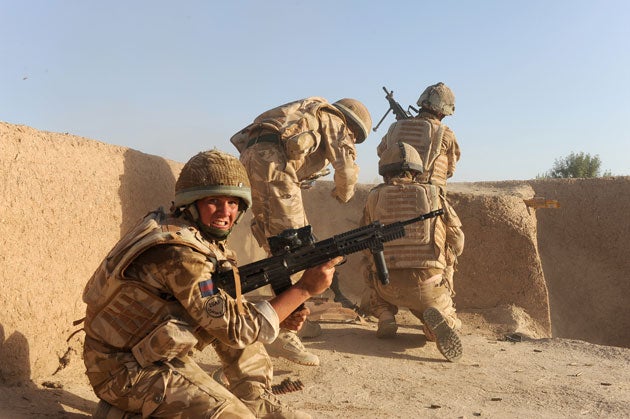British troops in final push to clear out insurgents
MoD says troops in Afghanistan are now engaged in fierce and close combat with Taliban fighters

Hundreds of British soldiers are involved in fierce fighting in the final phase of the latest push to drive the Taliban from Afghanistan's Helmand Province. The new offensive is now reaching a climax and has seen soldiers forced into close-quarters combat by Taliban ambushes and resorting to using hand grenades to flush out enemy fighters.
New details released by the Ministry of Defence today reveal how British soldiers have been fighting since Friday to clear the area north of Lashkar Gah of insurgents. They are having to contend with dozens of improvised explosive devices [IEDs] left by retreating Taliban fighters.
More than 700 soldiers from the Light Dragoons and 2nd Battalion, The Mercian Regiment, are involved in Operation Panther's Claw, which is seeing 3,000 British soldiers conducting operations to the north of Lashkar Gah while thousands of US soldiers are conducting similar operations south of the city in a joint effort against the Taliban. Afghan soldiers are also involved.
The offensive began two weeks ago, when hundreds of soldiers from the Black Watch captured three crossing points along the Nahr-e-Burgha canal, around 10 miles to the north of Lashkar Gah, after an airborne assault. Afghan soldiers and police helped to build a checkpoint there called "Hadrian's Wall" – in an attempt to allow local people to return to the previously deserted bazaar to resume normal life without fear of the Taliban. And just 11 days ago, soldiers from the Welsh Guards took control of 13 crossing points over the Shamalan canal in what defence officials described as "tough fighting ... in sweltering conditions".
Coalition forces aim to secure the area and restore confidence among local people there in advance of Afghanistan's presidential elections next month. Another goal is to enable reconstruction and aid projects to get underway in the region. Lt Colonel Nick Richardson, spokesman for Task Force Helmand, said: "We have already secured the crossings along two major waterways to the north of Lashkar Gah, recovered a large number of IEDs, fought back the enemy in several locations and cleared villages along the way."
The fighting has already cost the lives of two British soldiers, Lt Col Rupert Thorneloe, commanding officer of the 1st Battalion Welsh Guards, and Trooper Joshua Hammond, of 2nd Royal Tank Regiment, who died when their Viking vehicle was ripped apart by a roadside bomb last Wednesday.
Lt Col Thorneloe was the highest ranking army officer to be killed in action since the Falklands War.
But if the subsequent news coverage has been anything to go by, you could be forgiven for thinking that Lt Col Thorneloe was the only soldier to die. His death has been given a level of prominence – fuelled by personal plaudits from Prince Charles and politicians – rarely seen in the deaths of other soldiers. To date, there have been more than a thousand mentions of the senior officer in news reports on Google, in contrast to less than 600 for his junior colleague Trooper Joshua Hammond. Some postings on army internet forums hint at frustration at the way the death of the trooper has been overshadowed.
In the south, two US soldiers were killed when their base came under attack yesterday. The assault included an attempted suicide truck bombing of the base in the Zirok district of southeastern Paktika province. Multiple rocket and mortar rounds had been fired in the attack on the outpost, one of which contained white phosphorus. Afghanistan's Taliban has denied using the chemical, which bursts into flame on contact with the air and can cause horrific burns. A coalition spokesman said about 70 incidents of insurgents using or possessing white phosphorus had been documented since April. Most commonly used on battlefields as a smokescreen or for illumination, its use to deliberately target people is illegal. An eight-year-old girl was badly burned by white phosphorus in west Afghanistan in May, with the US military and the Taliban accusing each other of firing the round containing the chemical.
Over the border, Pakistani warplanes and helicopter gunships pounded Taliban positions in the country's volatile northwest on Saturday, killing at least 12 suspected insurgents, as the government kept up pressure on Islamist militants along the Afghan border. Elsewhere in the northwest, clashes between tribesmen and Taliban fighters left 16 people dead in the latest violence between pro-government tribal militias and insurgents.
Join our commenting forum
Join thought-provoking conversations, follow other Independent readers and see their replies
Comments